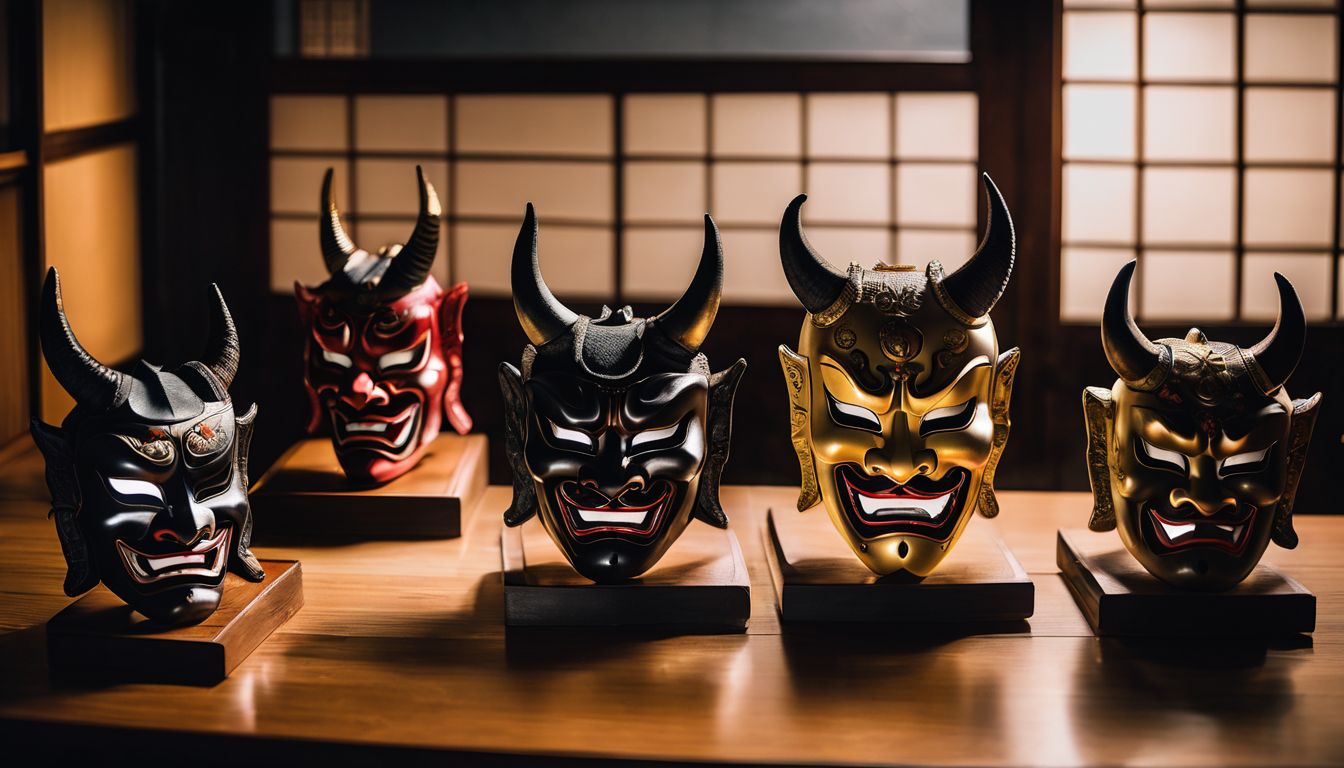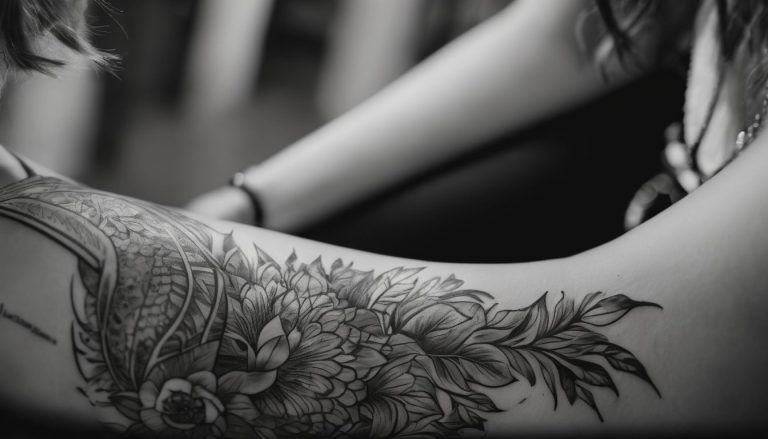Exploring the Symbolism of Japanese Mask Tattoos: Hannya and Oni Mask Meanings
Have you ever seen a tattoo of a fierce Japanese mask and wondered about its meaning? These intricate designs are not just for show; they carry rich symbolism dating back to ancient Japan.
This blog post will dive into the powerful meanings behind Hannya and Oni mask tattoos, revealing stories of passion, protection, and folklore. Keep reading to uncover the fascinating world behind these traditional tattoos!
Key Takeaways
- Hannya mask tattoos come from Japanese Noh theater and represent a woman’s emotional transformation into a demon, reflecting complex feelings like jealousy and rage.
- The symbolism of color in Hannya tattoos is significant; for instance, red signifies intense emotion, while black indicates full demonic transformation.
- Oni masks are inspired by male demons from Japanese folklore, known for causing trouble and chaos; these tattoos often feature vibrant colors to depict their menacing nature.
- Both Hannya and Oni mask tattoos hold cultural importance in Japan and embody different aspects of human emotions as well as connections to ancient myths and stories.
- People get these traditional Japanese mask tattoos for personal reasons, ranging from artistic expression of deep-seated emotions to tapping into the strength they symbolize.
The History and Symbolism of Hannya Mask Tattoos
Hannya mask tattoos have deep roots in Japanese culture and are often associated with traditional Noh theater. These tattoos symbolize the complexities of human emotions and the struggle between good and evil.
Meaning of Hannya Tattoos
Hannya tattoos symbolize complex human emotions and are deeply rooted in Japanese culture. They depict a woman’s transformation into a demon, driven by intense jealousy and anger, which is a common theme in traditional Noh plays.
The menacing look of the Hannya mask with its horned forehead, sharp metallic eyes, and leering mouth capture feelings of rage yet also convey deep sorrow and pain associated with love turned tragic.
Color plays an important role in conveying emotion through these tattoos. A red Hannya tattoo may indicate a woman who is still alive and filled with passion or desire, while darker colors like black suggest the character has fully transformed into a demon consumed by hatred.
This imagery comes from ancient lore where such masks were used to represent female spirits overwhelmed by negative emotions. As part of Japanese folklore tattoo art, wearing this symbol can express personal battles or serve as protection against malevolent forces—a gesture steeped in layers of cultural symbolism.
Top Hannya Tattoo Meanings
The top Hannya tattoo meanings are:
- Hannya mask tattoos often represent female rage, jealousy, and sorrow, embodying tragic love stories from Japanese folklore.
- These tattoos can symbolize the transformation of a woman into a demon due to intense emotions such as jealousy and anger.
- The snake featured in Hannya mask tattoos can symbolize good luck and immortality in ancient Japanese culture.
- Different colors used in Hannya mask tattoos hold significance, with each color representing varying emotions and meanings within the tattoo.
- A Hannya mask tattoo may serve as a form of artistic expression to convey deep-seated emotions or personal struggles through visual storytelling.
The Story of Hannya
The Hannya mask originates from ancient Japanese Noh theater and represents a female demon who has transformed due to intense jealousy and anger. This transformation is often linked to tragic love stories in Japanese folklore, making the Hannya an emblem of sorrow, revenge, and deep emotional pain.
The mask is depicted as fearsome and demonic, with its distinct expression symbolizing female rage and suffering.
Furthermore, the color of the Hannya mask also holds significant meaning in Japanese culture, with different hues representing various emotions and interpretations. From these origins stems a rich symbolism that makes Hannya masks popular in traditional Japanese tattoo art, embodying profound cultural significance while portraying elements of beauty intertwined with reminders of human struggles.
The Difference between Hannya and Oni Masks
Originating from Japanese folklore and theater, the Hannya and Oni masks each hold their own distinct meanings and symbolism in traditional Japanese tattoo culture. Understanding the origins and significance of these two iconic mask designs can provide valuable insight into their individual representation in tattoo art.
Origins and Meanings of Oni Masks
Oni masks, originating from Japanese folklore, hold deep cultural significance. These masks symbolize aggressive male demons and are often associated with evil and mischief. The Oni mask tattoos feature long fangs and skin colored in vibrant red or blue hues, representing the menacing nature of these mythical creatures.
In traditional Japanese art-inspired tattoos, the Oni mask is a popular choice due to its portrayal of power and ferocity.
The origins of Oni masks date back to ancient Japanese mythology, where these demonic entities were believed to cause chaos and torment humans. The symbolism behind Oni mask tattoos showcases their representation as malevolent beings capable of causing harm and destruction.
Comparing Hannya and Oni Mask Tattoos
– Comparing Hannya and Oni Mask Tattoos
The Hannya and Oni masks carry profound symbolism within Japanese culture, each representing different aspects of human emotions and behaviors. Below is a comparative breakdown of these iconic tattoos.
| Hannya Mask Tattoos | Oni Mask Tattoos |
|---|---|
| Symbolize intense jealousy, revenge, and sorrow. | Represent aggression, evil, and mischief. |
| Depict a woman transformed into a demon due to overwhelming rage. | Depict male demons, often seen with long fangs and colorful skin. |
| Associated with tragic love stories and female anger. | Symbolize malevolent figures and are linked to acts of evil. |
| Colors of the mask can indicate specific emotions or states of being. | Red and blue are common colors, symbolizing different demonic qualities. |
| Reflects deep emotional pain and the darker aspects of human experience. | Implies strength and protection against malevolent spirits. |
The significance of these mask tattoos stretches beyond their frightening appearances, delving into the human psyche and traditional folklore. Moving from the symbolic to the personal, let’s explore the reasons behind individuals choosing to ink Hannya tattoos onto their skin.
Why People Get Hannya Tattoos
People get Hannya tattoos for their personal symbolism and connection to Japanese culture. The intricate and enigmatic design of the Hannya mask also adds a unique and captivating element to tattoo art.
Personal Symbolism
When individuals choose to get Hannya or Oni mask tattoos, they often infuse personal symbolism into the design. The decision may stem from a connection to Japanese culture, a desire to embody the traits of strength and resilience associated with these masks, or an expression of their own inner emotions such as rage, pain, jealousy, or sorrow.
Some people select specific elements like snakes in their Hannya mask tattoo to symbolize good luck and immortality while others might incorporate botanical elements for aesthetic appeal and deeper meaning.
Additionally, the color choice for the mask can convey different emotions and significance based on traditional beliefs.
Connection to Japanese Culture
Japanese mask tattoos, such as the Hannya and Oni masks, hold deep cultural significance in Japanese tradition and folklore. These tattoos are deeply rooted in Japanese mythology and art, with each symbolizing different aspects of Japanese culture.
The Hannya mask represents tragic love stories and the transformation of a woman into a demon due to intense jealousy and anger, reflecting themes often found in traditional Japanese theater plays.
On the other hand, Oni mask tattoos symbolize malevolent demons from Japanese folklore, embodying notions of evil and mischief prominent in ancient tales and beliefs.
The Enigmatic Hannya Mask in Tattoo Form
Explore the popular designs and placements of Hannya mask tattoos, as well as the techniques and styles used to depict this enigmatic Japanese symbol. Discover how botanical elements are often incorporated into these striking tattoo designs.
Popular Designs and Placements
The Hannya mask is a popular choice for tattoos due to its rich cultural symbolism and striking imagery. Here are some popular designs and placements for Hannya mask tattoos:
- Intricate details: Hannya masks with intricate details such as sharp fangs, intense eyes, and contorted expressions are often chosen to capture the dramatic emotions they represent.
- Vibrant color schemes: Many opt for colorful Hannya masks, with red being a common choice to symbolize intense rage or passion, while blue can convey sadness or melancholy.
- Placement on the body: These tattoos are often placed on prominent areas such as the upper arm, shoulder blade, or back due to their complex and detailed design that benefits from a larger canvas.
- Pairing with other elements: Some individuals choose to incorporate additional elements like cherry blossoms or waves into their Hannya mask tattoos to further enhance the storytelling aspect and add visual interest.
- Contemporary styles: Modern interpretations of Hannya masks may integrate contemporary tattoo styles such as watercolor, dotwork, or geometric patterns, allowing for unique and personalized designs.
- Symbolic composition: For those seeking layered meanings in their tattoos, combining the Hannya mask with other Japanese symbols like snakes (representing immortality) or flowers (symbolizing life’s fleeting nature) adds depth to the overall narrative of the tattoo.
- Incorporating traditional Japanese art techniques: The use of traditional Japanese art techniques such as Irezumi (traditional Japanese tattooing) or Ukiyo-e (woodblock prints) can lend authenticity and cultural significance to Hannya mask tattoos.
Techniques and Styles
After considering popular designs and placements, it’s important to understand the techniques and styles used in creating Hannya and Oni mask tattoos. The following list presents a detailed explanation of the different techniques and styles associated with these traditional Japanese tattoos:
- Brushstroke Style: This technique imitates the fluidity of Japanese calligraphy, often depicting bold lines and dynamic movement to convey emotion and intensity within the tattoo design.
- Watercolor Technique: Incorporating watercolor effects into Hannya and Oni mask tattoos adds depth and dimension, creating a captivating visual impact that enhances the overall symbolism of these mythical creatures.
- Traditional Irezumi: Utilizing traditional Japanese tattooing methods, known as irezumi, involves hand-poking or hand-tapping needles into the skin, resulting in intricate and detailed designs with cultural significance.
- Neo-Traditional Approach: Combining modern elements with traditional Japanese tattoo aesthetics, this style infuses vibrant colors, intricate linework, and bold shading to create visually stunning representations of Hannya and Oni masks.
- Realism: Some individuals opt for a realistic portrayal of these masks, aiming for lifelike depictions that capture every detail of the facial expressions, from rage to anguish, adding an extra layer of depth to their meaning.
- Dotwork Technique: Using stippling or dotwork brings a unique texture to the tattoo design while also highlighting details such as facial features and expressions on both Hannya and Oni masks.
- Geometric Interpretations: Employing geometric shapes or patterns can offer a contemporary take on traditional Japanese mask tattoos while still retaining their cultural symbolism and historical significance.
- Blackwork Style: Focused on solid black ink designs with contrasting negative space, this style emphasizes bold lines and shading to create striking interpretations of Hannya and Oni masks that stand out on the skin.
Incorporating Botanical Elements
Incorporating botanical elements into Hannya and Oni mask tattoos adds an intriguing layer of symbolism to the design. For instance, cherry blossoms represent beauty, fragility, and the transient nature of life in Japanese culture.
Integrating these delicate flowers into a Hannya or Oni mask tattoo can symbolize transformation and change. Similarly, adding peonies to the tattoo design can convey wealth, honor, and prosperity while also offering protection from malevolent forces due to their association with good fortune.
In addition to floral elements, incorporating swirling water patterns or waves in the tattoo design can evoke themes of strength, resilience, and adaptation – important symbols that complement the intense emotions represented by Hannya and Oni masks.
By skillfully integrating botanical elements such as cherry blossoms, peonies, and water patterns within these traditional Japanese mask tattoos, individuals not only infuse their designs with deeper meaning but also pay homage to Japan’s rich cultural heritage.
Conclusion
In exploring the symbolism of Japanese mask tattoos, we uncover deep cultural and historical significance in Japanese folklore. The Hannya and Oni masks represent powerful emotions such as jealousy, revenge, rage, and sorrow.
These tattoo designs serve as a captivating link to ancient Japanese mythology and tradition. Artists skillfully incorporate these symbolic elements into stunning visual representations that resonate with individuals drawn to their meaning and aesthetic appeal.
The enigmatic allure of Hannya and Oni mask tattoos continues to captivate those seeking meaningful and visually striking body art.
FAQs
1. What do Japanese mask tattoos represent?
Japanese mask tattoos are rich in cultural symbolism, representing traditional Japanese mythology and folklore by using images of mythical creatures like the Hannya and Oni masks.
2. Can you tell me about the Hannya mask symbolism in tattoos?
The Hannya mask represents complex emotions such as jealousy and sorrow; in a tattoo, it may symbolize overcoming difficult times or transformations in one’s life inspired by Japanese art and folklore.
3. What’s the meaning behind an Oni mask tattoo?
An Oni mask tattoo stands for protection against evil spirits since Onis are known as demons or ogres in Japanese culture; it often signifies strength and the ability to conquer challenges based on traditional Japanese demon myths.
4. How does a Japanese demon mask tattoo connect with cultural heritage?
A Japanese demon (Oni) or creature (Hannya) mask tattoo connects deeply with Japan’s theatrical history, drawing from classical stories that reflect aspects of human nature and moral lessons through symbolic imagery.
5. Why might someone choose a traditional Japanese mythology tattoo over others?
Someone might pick a traditional Japanese mythology tattoo for its timeless aesthetic grounded in historical significance, profound meanings derived from ancient stories, or personal identification with the attributes they believe these powerful symbols express.







